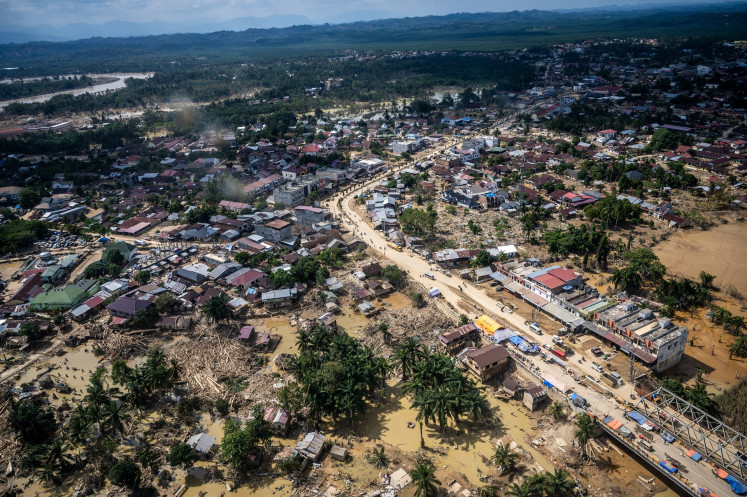Popular Reads
Top Results
Can't find what you're looking for?
View all search resultsPopular Reads
Top Results
Can't find what you're looking for?
View all search resultsSearching for Tanah Abang's forgotten history
Before and after: A guide holds a photo depicting colonial Tanah Abang
Change text size
Gift Premium Articles
to Anyone
Before and after: A guide holds a photo depicting colonial Tanah Abang. The area now is full of shop houses
A tour is presenting people with a chance to experience the storied history of Tanah Abang, Central Jakarta.
One of Jakarta's most bustling commercial areas, Tanah Abang is famed as a shopping destination for residents of the city ' as well as vendors throughout the archipelago.
Little do those visitors know that the region is filled with buildings that preserve the history of the nation's colonial era in the 18th and 19th centuries. Sahabat Museum, a community of history lovers, wants to change that situation.
'No one really considers Tanah Abang as a tourist destination,' Ade Purnama, the founder of Sahabat Museum, told The Jakarta Post recently. 'Once people learn its history before it grew into a commercial district, they will realize there are so many interesting places to visit.'
Sahabat Museum, known for organizing trips to historical sites around the nation, arranged for its Tanah Abang tour earlier this month, charging patrons Rp 300,000 for the experience.
During the one-day trip, Sahabat Museum took the participants around Tanah Abang by foot.
Despite the heat, about 100 people walked around the district, visiting museums as well as colonial houses and buildings.
In search of: Sven Verbeek (with microphone) shows the tombstones of his great-great-grandparents at Museum Prastasi.
There were also some special guests: Scott Merrillees, the author of Greetings from Jakarta: Postcards of a Capital 1900-1950, and his friend Sven Verbeek, whose ancestors were colonial landholders in Tanah Abang.
Ade said that the tour was organized with the help of the men. 'Sven and Scott have all the detailed data and photos of how was Tanah Abang was in the past.'
Merrilless has published several photo books about Jakarta, including Batavia in Nineteenth Century; while Verbeek, a Sydney-based musician and blogger, said that he has been researching his family for more than two decades.
'My late grandmother always told me about her past in Jakarta and the story triggered me to trace my family history here,' Verbeek said.
Verbeek's great-great-grandparents are Pieter Albert and Jeannette de Nijs Bik, who lived in a massive estate called Tanah Abang Heuvel Landhuis.
Based on interviews with his grandmothers, a review of the family's photo collection and research, Verbeek has put together all the pieces of his family's past in Jakarta available online at facebook.com/tanahabangtempodulu.
The Sahabat Museum's Tanah Abang tour traces the district's history through the lens of the de Nijs Bik family.
And so it goes: Ade Purnama, the founder of Sahabat Museum, leads a tour group to an old Unilever factory.
The tour started in the morning at the Museum Taman Prastasti, which preserves the headstones from a colonial cemetery. A brief explanation on the history of Tanah Abang was given by Andy Alexander, a tour guide from Sahabat Museum.
Andy said that Tanah Abang, which means red earth, received its name from the troops of Sultan Agung of the Mataram Kingdom after a futile attack on the town of Batavia (old Jakarta).
In the 17th century, Tanah Abang was how many agricultural products found their way to Kota, once the capital of Batavia.
It grew into a well-situated neighborhood where many wealthy Europeans lived. The area also became a popular location for consulates. The area was quite peaceful and green and had the rural character of a garden town.
From Museum Taman Prasasti, the tour continued to Tanah Abang West, the former site of many small businesses and factories, such as Fuchs & Rens, Batavia's main supplier of cars and tires. Two of its three buildings were demolished in the 21th century to make way for a restaurant.
Next was Lever's Zeepfabriek (Unilever's soap factory), which opened in 1941. The building has been preserved by its current owner.
The group then explored Tanah Abang Heuvel (hill), where Verbeek's ancestors lived. The guides explained that the area was used as a relaxation site by Batavia rulers before it was turned into a country estate by Governor-General Gustaaf Willem van Imhoff in 1740.
What now remains: This building, currently a Bank Mandiri branch, was owned by wealthy Chinese in the 19th century.
The estate, owned by Verbeek's great-great-grandfather in 1863, included 4 huge houses. The area has been turned into shophouses in the Tanah Abang shopping complexes.
The tour moved to the Textile Museum and other historical sites in Tanah Abang, including the famous Ar-Rohah mosque, believed to be one of the oldest in Batavia and dating to the 1850s.
Despite the tour's size, members of the group remained excited.
Among them was 42-year-old Eri Heriawati, who came along with her nieces and nephews. Undeterred by the heat, Eri said she liked to visit one spot after another to learn more about Jakarta's history.
'I took the children with me because I want them to learn more about the history of their ancestors. Their grandmother comes from Jakarta,' she said.
The tour group comprised people aged from 7 to 56, including many children.
One of Eri's nephews, Muhammad Rizqi, said the tour was not his first trip. He has joined previous Sahabat Museum on excursions to Jakarta's Old Town in Kota, West Jakarta, among others.
'Learning history through this activity is fun, rather than reading it from books,' the 15-year-old said.
For more information, visit sahabatmuseum.org.
Historic: The Ar-Rohah Mosque, believed to be one of the oldest in the city.
Blast from the past: History enthusiasts gather at Museum Prasasti to join Tanah Abang's blast-from-the-past tour.
' Photos by JP/Ika Krismantari















